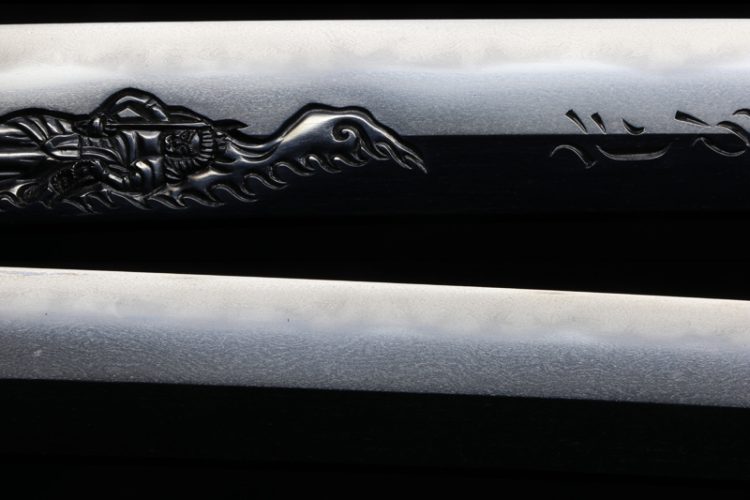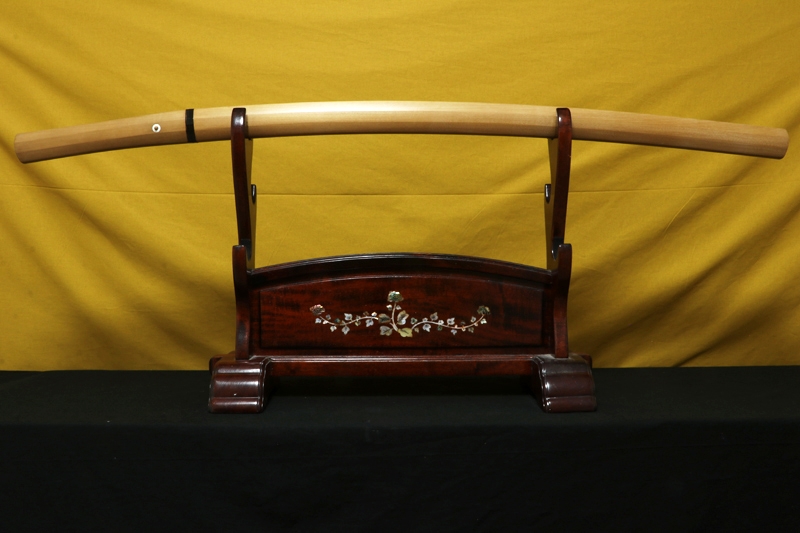説明
「刀姿 sword figure」
鎬造り庵棟、身幅やや太く尋常重厚く、反りやや浅く、中鋒。茎は生で切鑢がかかり、茎尻は栗尻。
「彫り物 carving」
差表は不動明王と不動明王の梵字。差裏は龍の彫が入る。
「地鉄 jigane」
地鉄は、板目肌がよく詰み、地沸良く付く。
「刃紋 hamon」
刃紋は、小沸出来の丁子乱れとなり足良く入り砂流かかり、刃中は金筋が働く。釯子は乱れ込み先掃掛となり返る。
「特徴 detailed」
酒井一貫斎繁政(本名:酒井寛)は、1905年(明治38年)に静岡市音羽町で、宮口正寿刀匠の弟である酒井安次郎の三男として生まれました。
1921年(大正10年)、笠間繁継師に入門。約15年の修業を経て、師から「繁」の字を授かり、繁政と名乗るようになりました。1933年(昭和8年)、靖国神社日本刀鍛錬会に入所し、1936年(昭和11年)には大倉日本刀鍛錬所に移ります。1941年(昭和16年)、東京都板橋区に独立し工房を開設、陸軍受命刀匠として認定されました。さらに1944年(昭和19年)には海軍受命刀匠にも認定されました。
戦後は「一貫斎繁政」と名乗り、精力的に作刀を続け、多くの賞を受賞しました。1981年(昭和56年)には、日本美術刀剣保存協会(NBTHK)より無鑑査刀匠に認定されます。1996年(平成8年)、91歳で逝去。
酒井一貫斎繁政は、戦前・戦後を通じて日本刀史にその名を刻む、名高い刀匠として広く称賛されています。
本作は、長さ二尺五寸七分(約78cm)の刀身に精緻な地鉄を鍛え、見事な丁子乱れの刃文を焼き上げた作品です。差表には不動明王、差裏には龍を彫り込んだ見事な彫刻が施されており、非常に高い技術を示しています。
また、鎺は金無垢(18金、60g)で作られており、それだけで60万円以上の価値があります。
Sakai Ikkan-sai Shigemasa, whose real name was Hiroshi Sakai, was born in 1905 (Meiji 38) in Otowacho, Shizuoka City, as the third son of Yasujirō Sakai, a younger brother of swordsmith Miyaguchi Masatoshi.
In 1921 (Taisho 10), he became an apprentice to Kasama Shigetsugu. After nearly 15 years of training, he received the character “Shige” (繁) from his master and adopted the name Shigemasa. In 1933 (Showa 8), he joined the Yasukuni Shrine Sword Forging Association, and in 1936 (Showa 11), he moved to the Okura Japanese Sword Forging Workshop. By 1941 (Showa 16), he had established his own workshop in Itabashi Ward, Tokyo, and was recognized as an officially appointed swordsmith for the Japanese Army. Furthermore, in 1944 (Showa 19), he was also certified as an officially appointed swordsmith for the Japanese Navy.
After the war, he adopted the name Ikkan-sai Shigemasa and continued sword-making with great enthusiasm, receiving numerous awards. In 1981 (Showa 56), he was designated as a Mukansa swordsmith by the Nihon Bijutsu Token Hozon Kyokai (NBTHK). He passed away in 1996 (Heisei 8) at the age of 91.
Sakai Ikkan-sai Shigemasa is celebrated as an illustrious master swordsmith who left a profound mark on the history of Japanese sword-making both before and after the war.
This piece features a long blade measuring 2 shaku 5 sun 7 bu (approximately 78 cm), crafted with finely forged jigane (steel surface) and a magnificent choji-midare hamon (clove-patterned temper line). The blade is adorned with intricate carvings: Fudo Myo-o (Acala) on the omote side and a dragon on the ura side, showcasing exceptional craftsmanship.
Additionally, the habaki is made of solid gold (18 karat, 60 grams), valued at over 600,000 yen alone.
「拵 Koshirae」
ハバキ(habaki) :金無垢二重(18金で60g)。
鞘(Saya) :白鞘。
「刀剣の状態 condition of blade」
研:良好です。
傷:欠点に成るような傷は有りません。





















